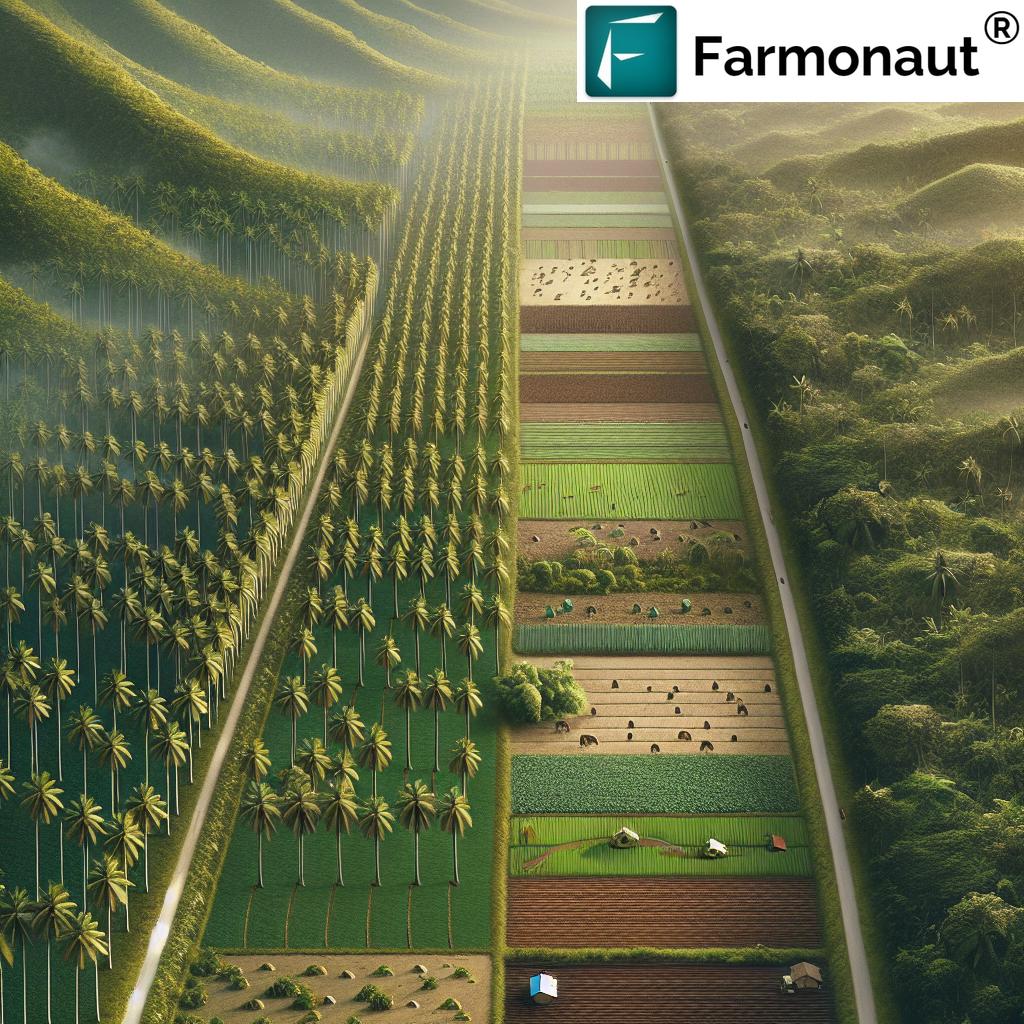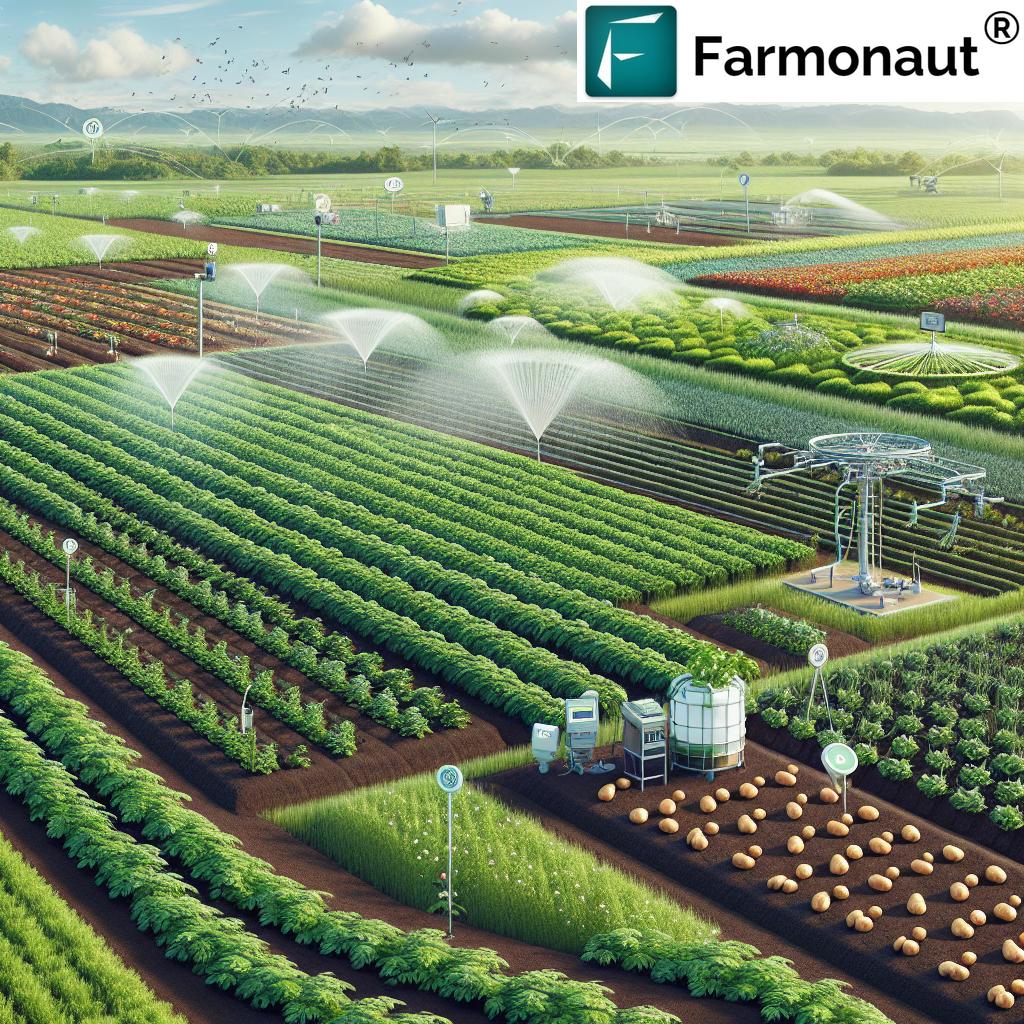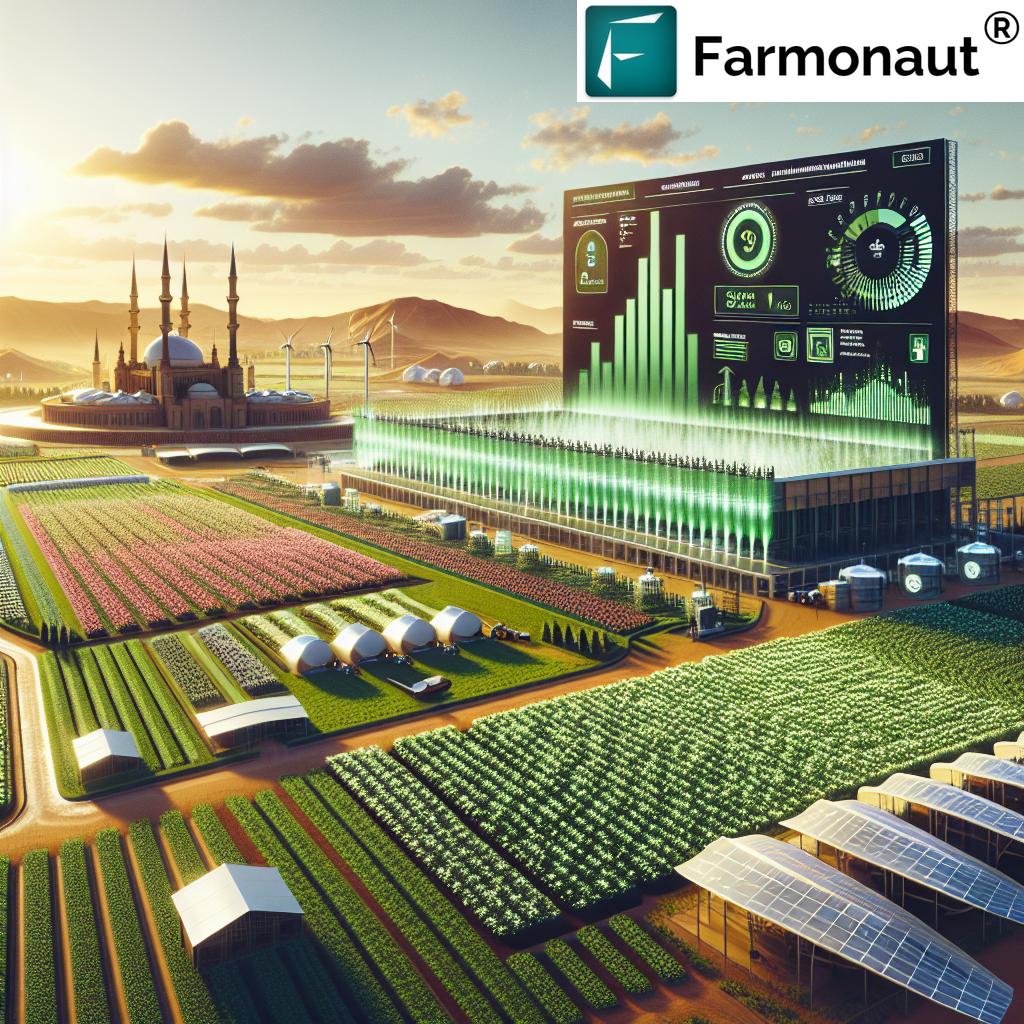Philippines Land Use: Top 7 Agriculture Challenges
“Over 30% of the Philippines’ land is used for agriculture, with rice and coconut as leading crops.”
“The Philippines loses about 47,000 hectares of forest yearly, impacting sustainable agriculture and community resilience.”
Table of Contents
- Introduction
- Agricultural Land Use in the Philippines: An Overview
- Top 7 Agriculture Challenges in the Philippines: An Overview
- 1. Deforestation in the Philippines
- 2. Land Degradation and Soil Erosion
- 3. Climate Change Impacts on Philippine Agriculture
- 4. Land Reform in the Philippines
- 5. Rice Production Challenges
- 6. Coconut Cultivation Challenges
- 7. Sustainable Agriculture Practices and Community Engagement
- Comparative Table: Top 7 Challenges & Solutions
- Technological Solutions for Philippine Agricultural Land Use
- Philippines Conservation Efforts and Community-Based Forest Management
- Farmonaut’s Tools for Sustainable Land and Crop Management
- Frequently Asked Questions
- Conclusion
Introduction: Exploring Philippines Land Use & Agriculture Challenges
The agricultural land use in the Philippines forms the backbone of our archipelagic country’s economy and heritage. With its tropical climate, rich biodiversity, and unique geography across over 7,000 islands, the Philippine landscape is a complex tapestry of rice paddies, coconut plantations, and verdant forests. Yet, while our natural resources offer immense opportunities, they also present profound challenges. We face ongoing issues such as deforestation, land degradation, and the mounting pressures of climate change.
As we explore the dynamic interplay of agriculture, forestry, and sustainable practices, our focus is on ensuring the resilience of communities, protection of the environment, and lasting economic progress. This comprehensive guide delves into the Top 7 Agriculture Challenges in the Philippines, drawing on the most current data, government programs, and innovative solutions—particularly the role of technology—in shaping the future of our land.
Agricultural Land Use in the Philippines: An Overview
In the Philippines, over 30% of the total land—that is, over 9 million hectares—is cultivated for agricultural activities. Our diverse islands feature a range of crops, ensuring both food security and a vital export sector. From the lush rice fields of Nueva Ecija to the coconut groves in Southern Mindanao and the traditional Ifugao Rice Terraces in the Cordilleras, our country’s landscape exemplifies the interweaving of culture, environment, and production.
- Rice production in the Philippines remains central—being the staple food and employing millions of farm households.
- Coconut cultivation Philippines forms a critical livelihood base, especially in Southern Tagalog, Bicol, Eastern Visayas, and Mindanao.
- Other significant crops include maize (corn), sugarcane, bananas, pineapples, mangoes, and coffee.
- The forestry sector covers about 23% of the country’s land area, playing a crucial role in biodiversity and natural resources Philippines.
Yet, we must acknowledge that our natural resources—including arable land and forests—are under significant pressure from unsustainable practices, urbanization, and environmental shifts.
Top 7 Agriculture Challenges in the Philippines: An Overview
For us in the Philippines, the following are the most critical agricultural challenges impacting sustainable practices, community livelihoods, and national economic growth:
- Deforestation in the Philippines
- Land Degradation and Soil Erosion
- Climate Change Impacts on Philippine Agriculture
- Land Reform in the Philippines
- Challenges in Rice Production
- Challenges in Coconut Cultivation
- Promoting Sustainable Agriculture and Community-Based Management
Let us explore these pressing agricultural land use in the Philippines issues in detail, followed by solutions to address them sustainably.
“Over 30% of the Philippines’ land is used for agriculture, with rice and coconut as leading crops.”
1. Deforestation in the Philippines: A Persistent Threat to Land and Communities
Deforestation in the Philippines represents one of the gravest challenges to our natural resources, forestry sector, and community resilience. Historical records show a sharp decline in forest cover: from 70% in the early 20th century to just 23% by 2010. Each year, we experience a loss of around 47,000 hectares of forest. This depletion is primarily due to:
- Unregulated logging and illegal timber harvesting
- Agricultural expansion, especially slash-and-burn (kaingin) practices
- Conversion of forest areas to settlements and mining zones
- Natural disasters such as typhoons and landslides
The impacts of deforestation extend well beyond the loss of tree cover:
- Biodiversity loss: threatening endemic flora and fauna
- Soil erosion and land degradation, reducing agricultural productivity
- Increased vulnerability to flooding and natural hazards
- Reduced capacity of forests to sequester carbon, exacerbating climate change
Integrated solutions—such as Community-Based Forest Management (CBFM) and national reforestation drives—are crucial in reversing this trend and promoting sustainable land use for future generations.
2. Land Degradation and Soil Erosion Affecting Agricultural Productivity
The steep terrain of many Philippine islands, coupled with unsustainable agricultural practices, has led to widespread land degradation and soil erosion. Intensive use of land—especially in rice and coconut growing areas—without proper conservation strategies depletes nutrients and reduces yields.
- Soil erosion strips away nutrient-rich topsoil, lowering crop productivity and leading to increased use of fertilizers and chemical inputs.
- In lowland areas, improper irrigation and poor drainage exacerbate salinization and reduce land fertility.
- Mountainous regions, such as in Northern Luzon and Mindanao, are particularly susceptible due to deforestation and steep slopes.
To address these issues, we must promote:
- Agroforestry and cover cropping—integrating trees with crops to stabilize soil and improve micro-climates
- Reduced tillage and contour plowing
- The use of organic fertilizers and mulching
Modern solutions like Farmonaut’s satellite-based crop health monitoring help us proactively identify soil moisture deficits and land degradation risks, enabling sustainable management across regions.
3. Climate Change Impacts on Philippine Agriculture
As a Southeast Asian nation vulnerable to typhoons, droughts, and rising sea levels, the Philippines experiences some of the world’s most severe climate change impacts on Philippine agriculture. These impacts are becoming more stark every year:
- Frequent super-typhoons (e.g., Typhoon Haiyan in 2013) have devastated tens of thousands of hectares of agricultural lands, with billions of pesos in economic loss.
- Changing rainfall patterns and prolonged droughts (El Niño) lead to water scarcity in major rice-growing regions like Central Luzon and Cagayan Valley.
- Rising temperatures and humidity heighten pest outbreaks and crop diseases.
- Sea-level rise threatens coastal farmlands and fishing communities.
The agricultural sector is projected to face a 2.2% annual GDP loss by 2100 if these environmental challenges are left unaddressed. Thus, building resilience through climate-smart agriculture practices, robust disaster response, and adaptive crop technologies is imperative for our food security and livelihoods.
To help Filipino agribusinesses and farmers reduce their environmental impact, Farmonaut’s Carbon Footprinting Solution offers real-time emissions tracking. This empowers local producers to meet global sustainability standards while lowering resource wastage.
4. Land Reform in the Philippines: Equity and Efficiency Issues
The Comprehensive Agrarian Reform Program (CARP) and its extension, CARPER, were launched to promote equitable land distribution and empower landless farmers. While more than 5 million hectares have been redistributed, significant gaps and inefficiencies persist:
- Incomplete land transfer and delayed issuance of land titles in many regions (notably in Negros, Visayas, and Mindanao)
- Lack of support services, access to credit, and farm inputs for ARBs (agrarian reform beneficiaries)
- Fragmented farm holdings, making scaling up agricultural production and mechanization challenging
- Land conversion for non-agricultural use undermines long-term food security
Solving these issues involves:
- Accelerating land titling and legal processes
- Investing in rural infrastructure and value-added services
- Promoting collective land management and cooperative farming
- Leveraging technology platforms like Farmonaut’s Large-Scale Farm Management for plantation monitoring, compliance, and improved farm administration
5. Rice Production Challenges: Self-Sufficiency, Productivity, and Imports
With rice production in the Philippines accounting for more than 21% of agricultural GDP, the staple food is grown by nearly 2.5 million farm households across Luzon, Visayas, and Mindanao.
- Despite being the world’s 8th largest producer, the country remains one of the biggest rice importers, reflecting a self-sufficiency gap.
- Rice yields (average 4.0 MT/ha) stagnate due to aging irrigation infrastructure, pest outbreaks, and acidic or nutrient-depleted soils.
- Climate extremes and excessive use of chemicals pose risks to productivity and food safety.
- The fragmentation of rice lands and limited access to modern technologies hinder competitiveness.
Promoting sustainable agriculture practices—such as precision farming using satellite data, integrated pest management, and organic agriculture—can help Filipino rice farmers bridge yield gaps while conserving valuable resources.
For easier and faster access to farm financing, insurance, and disaster recovery, Farmonaut’s Crop Loan Verification & Insurance Solutions provide satellite-based farm area verification. This reduces fraud and helps our rice farmers recover swiftly from climate disasters.
6. Coconut Cultivation Challenges: Disease and Market Vulnerability
The coconut sector forms a quarter of our agricultural land, with 3.5 million hectares spanning Southern Tagalog, Bicol, Eastern Visayas, and large parts of Mindanao. Coconuts are essential for both domestic food products and the export economy. However, we face multiple pressing concerns:
- Coconut scale insect infestations and diseases threaten plantations, especially in Southern Luzon and Mindanao.
- Low smallholder incomes, aging trees, and lack of replanting programs affect livelihoods.
- Price fluctuations and competition in the global market add further risk.
Merging traditional coconut management with satellite-based disease detection, timely replanting, and sustainable agroforestry can help ensure the sector’s long-term sustainability and community resilience.
Farmonaut’s Crop Plantation, Forest, and Plantation Management Tools empower us to monitor thousands of coconut hectares using satellite imagery, track disease infestations, and improve field operations.
7. Sustainable Agriculture Practices and Strengthening Community Engagement
Ultimately, the sustainability of Philippine land use depends on how we balance food production, environmental conservation, and social equity. Key priorities include:
- Disseminating sustainable agriculture practices—organic farming, integrated pest management, crop rotation, and locally-adapted agroecology
- Promoting community-based forest management (CBFM), involving communities in protecting forests and practicing agroforestry
- Supporting traditional knowledge such as the management of the Ifugao Rice Terraces in the Cordilleras—a model of harmonious land use and cultural heritage
- Building local capacity through training, extension services, and digital platforms
The synergy of policy, grassroots engagement, and technology will lead us toward climate resilience and environmental stewardship.
Comparative Table: Top 7 Agricultural Challenges and Sustainable Solutions
| Challenge Name | Estimated Affected Land Area (ha) | Main Crops/Regions Impacted | Est. % of Total Agri Land | Short Description | Suggested Sustainable Practice |
|---|---|---|---|---|---|
| Deforestation | ~1,200,000 | Forest areas (Luzon, Mindanao, Visayas) | 13% | Loss of native forest cover due to logging, agri expansion, mining | Reforestation, CBFM, protected areas policy |
| Land Degradation/Soil Erosion | ~1,000,000 | Uplands, rice/corn fields (Northern Luzon, Mindanao) | 11% | Productivity losses from topsoil loss and chemical overuse | Agroforestry, contour farming, organic inputs |
| Climate Change Impacts | ~1,500,000 | Rice, coconut regions (Central Luzon, Bicol, Visayas, Mindanao) | 17% | Typhoons, droughts, sea rise, unpredictable seasons | Climate-smart agriculture, early warning systems |
| Land Reform Gaps | ~600,000 | Agrarian reform zones (Negros, Mindanao, Visayas) | 7% | Unfinished redistribution, lacking support for ARBs | Accelerated titling & services, cooperative farming |
| Rice Production Issues | ~2,700,000 | Rice fields (Central Luzon, Cagayan, Visayas, Mindanao) | 31% | Low yields, import reliance, irrigation stress | Precision farming, IPM, hybrid/organic rice |
| Coconut Sector Risk | ~3,500,000 | Coconut farms (Southern Tagalog, Bicol, Mindanao, Visayas) | 39% | Disease, aging trees, market instability | Replanting, pest monitoring, value-chain dev. |
| Sustainable Agriculture Gaps | Nationwide (all agri regions) | All crops/regions | — | Low adoption of eco-friendly practices | Farmer training, policy support, tech adoption |
“The Philippines loses about 47,000 hectares of forest yearly, impacting sustainable agriculture and community resilience.”
Leveraging Technological Solutions for Agricultural Land Use Challenges
Modern technology is rapidly changing how we approach agricultural management in the Philippines. Advanced solutions can improve yield, reduce environmental impact, and ensure data-driven decision-making across vast plantations.
Farmonaut’s Satellite-Based and AI-Driven Services:
- Satellite Crop Health Monitoring: Real-time NDVI and crop health tracking help farmers optimize irrigation, fertilizer use, and pest management.
- Jeevn AI Advisory: Personalized and timely farm management guidance powered by AI supports both smallholders and plantation managers.
- Blockchain Product Traceability: Guarantees transparent supply chains for Philippine agri exports, boosting trust for domestic and export markets.
- Resource & Fleet Management: For agribusinesses, efficient logistical management cuts costs and improves safety, especially in large-scale coconut and rice plantations.
- Carbon Footprinting: Enables businesses to meet sustainability targets and comply with global environmental standards.
Learn more about Product Traceability Solutions for Philippine agri exports.
By integrating these tools, we are better equipped to address our most persistent agriculture challenges and foster resilient Filipino communities.
Philippines Conservation Efforts: Community-Based Forest Management & Heritage Terraces
The Philippine government has aggressively championed conservation efforts to safeguard biodiversity and natural resources Philippines. Major programs and local traditions include:
-
Community-Based Forest Management (CBFM):
Since 1995, over 6 million hectares have been allocated to >5,500 CBFM projects, empowering local communities to manage forests, harvest resources sustainably, and protect against illegal activities. -
National Greening Program:
Launched in 2011, this initiative has restored millions of hectares of denuded public land, planting native and economically valuable trees. -
Ifugao Rice Terraces:
A UNESCO World Heritage Site, these centuries-old terraces represent sustainable, adaptive land-use and community-driven water management—models for environmental stewardship nationwide.
Through targeted policies, NGO involvement, and the fusion of traditional and digital management, these initiatives inspire a new era of integrated, sustainable development for our land.
Developers and agtech businesses can integrate Farmonaut’s Satellite & Weather API for automated crop, biomass, and weather monitoring—ensuring rapid, up-to-date field data. View API Developer Docs for complete reference.
Farmonaut’s Tools for Resilient & Sustainable Philippine Agriculture
Our vision for sustainable agriculture in the Philippines is realized through digital empowerment, affordable precision farming, and environmental stewardship. Farmonaut’s comprehensive suite empowers farmers and policymakers at every level—helping us:
- Predict, analyze, and respond to crop stress or pest risks—even before visible symptoms occur
- Systematically reduce input waste, improving income and minimizing environmental harm
- Increase efficiency in plantation and fleet management for large and small operations
- Demonstrate supply chain transparency—especially for export-sensitive crops like coconut, banana, pineapple, and rice
- Track and reduce carbon footprint, supporting global sustainability goals and local compliance
Design custom plantation and crop management workflows for your region with Farmonaut’s Fleet and Resource Management Tools.
Let us harness these technologies to build prosperous, climate-resilient Filipino farming systems.
Frequently Asked Questions (FAQs)
Q1: What percentage of Philippine land is used for agriculture?
Around 32% of total land in the Philippines—over 9 million hectares—is used for agricultural purposes, including rice, coconut, corn, sugarcane, and other crops.
Q2: Why is deforestation still a major issue in the Philippines?
Deforestation in the Philippines continues due to illegal logging, agricultural expansion, infrastructure projects, and natural disasters like typhoons. It results in severe biodiversity loss, economic and community vulnerability, and environmental degradation.
Q3: How does climate change impact Philippine farmers?
Climate change impacts on Philippine agriculture include unpredictable weather, increased typhoons and floods, droughts in major rice-growing regions, pest infestations, and loss of coastal arable land, all threatening farmer livelihoods and national food security.
Q4: What are the main crops cultivated in the Philippines?
Rice and coconut are the two primary crops by land area and economic contribution, followed by corn, bananas, pineapple, sugarcane, coffee, and high-value vegetables and fruits.
Q5: What is Community-Based Forest Management (CBFM)?
CBFM is a government-led program that devolves forest management to local communities, allowing them to sustainably utilize resources and rehabilitate degraded lands. It covers over 6 million hectares nationwide.
Q6: How can technology help address agricultural challenges in the Philippines?
Platforms like Farmonaut use satellite data, AI, and blockchain to optimize resource use, predict risks, improve farm financing, and increase transparency and sustainability in the agricultural sector.
Conclusion: Shaping a Sustainable Future for Philippine Land and Agriculture
Our journey through the agricultural land use in the Philippines highlights both the wealth of our natural heritage and the pressing challenges that threaten our environment, economy, and livelihoods. By tackling issues—deforestation, land degradation, climate change impacts, and more—through a combination of policy reforms, community-driven initiatives, and cutting-edge technology, we can ensure our land remains productive and sustainable for generations.
Let us work together—farmers, communities, government, and technology partners—to protect our forests, enhance our farms, and build resilient, thriving rural economies throughout the archipelago. The future of our food, environment, and culture depends on how we use and care for our land today.













